
Stratiotes is a genus of submerged aquatic plant commonly known as water soldiers, described as a genus by Linnaeus in 1753. Several specific names have been coined within the genus, but at present only one is recognized: Stratiotes aloides. native to Europe and NW Asia.

Menyanthaceae is a family of aquatic and wetland plants in the order Asterales. There are approximately 60-70 species in six genera distributed worldwide. The simple or compound leaves arise alternately from a creeping rhizome. In the submersed aquatic genus Nymphoides, leaves are floating and support a lax, umbellate or racemose inflorescence. In other genera the inflorescence is erect and consists of one to many flowers. The sympetalous, insect-pollinated flowers are five-parted and either yellow or white. The petals are ciliate or adorned with lateral wings. Fruit type is a capsule.

Nymphoides, or floatingheart, is a genus of aquatic flowering plants in the family Menyanthaceae. The genus name refers to their resemblance to the water lily Nymphaea. Nymphoides are aquatic plants with submerged roots and floating leaves that hold the small flowers above the water surface. Flowers are sympetalous, most often divided into five lobes (petals). The petals are either yellow or white, and may be adorned with lateral wings or covered in small hairs. The inflorescence consists of either an umbellate cluster of flowers or a lax raceme, with internodes occurring between generally paired flowers.
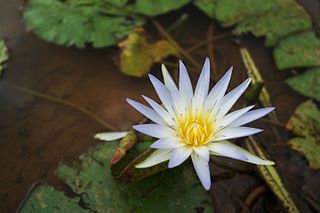
Nymphaea nouchali var. caerulea, is a water lily in the genus Nymphaea, a botanical variety of Nymphaea nouchali.

Madayi. is a Census Town and Grama panchayat in Kannur district of Kerala state, India. Bhagavathy shrine, Madayi Kavu where devotees worship Bhadrakali, is located here. The Goddess is one of the family deity of the Chirakkal Royal family, and the temple is known for the Koyikalasham. The temple was one of the few to survive desecration by the armies of Tippu Sultan, which devotees attribute to the grace of the Goddess. The Kolathiri Rajahs were the administrators of the temple, however recently the administration was transferred to the Malabar Devaswom Board. Nearby is the Vadukunnu Temple dedicated to Shiva. The temple was razed by followers of Tippu Sultan in the 18th century, but the temple has been rebuilt and is a vibrant centre of religion in the region.

Limnocharitaceae was a family of flowering plants in the monocot order Alismatales. In the APG IV system, it is included in the family Alismataceae. It is commonly known as the water poppy family. Species that have been placed in this taxon are small, perennial, aquatic herbs, native to the tropics, but adventive or naturalized in the subtropics as a result of cultivation.

Brasenia, commonly known as watershield, is a genus belonging to the family Cabombaceae, consisting of one species, Brasenia schreberi. It is widely distributed in North America, the West Indies, northern South America, eastern Asia, Australia, the Indian Subcontinent, and parts of Africa.

Najas minor, known as brittle naiad or brittle waternymph, is an annual aquatic plant, a submersed herb. It is native to Europe, Asia and North Africa from the Netherlands to Morocco east to Japan and the Philippines, including China, Siberia, Central Asia, Iran, Turkey, Ukraine, Germany, France Italy and a host of other countries. It is now introduced to North America and considered a weedy invasive species in the eastern half of the United States from Florida to Oklahoma to New Hampshire to Ontario to South Dakota. This plant prefers calm waters, such as ponds, reservoirs, and lakes, and is capable of growing in depths up to 4 meters.

Ipomoea indica is a species of flowering plant in the family Convolvulaceae, known by several common names, including blue morning glory, oceanblue morning glory, koali awa, and blue dawn flower. It bears heart-shaped or three-lobed leaves and purple or blue funnel-shaped flowers 6–8 cm (2–3 in) in diameter, from spring to autumn. The flowers produced by the plant are hermaphroditic. This plant has gained the Royal Horticultural Society's Award of Garden Merit.
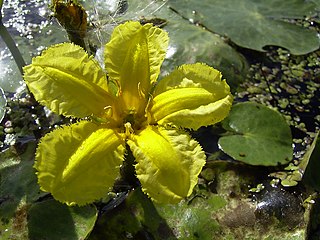
Nymphoides peltata is perennial, rooted aquatic plant with floating leaves of the family Menyanthaceae.

Nymphoides aquatica is an aquatic plant in the Menyanthaceae, native to the southeastern United States from Texas to Maryland. It is known variously as the banana plant, banana lily, and the big floatingheart. It is most commonly called the banana plant because of its banana-shaped roots. These unusual roots store nutrients.
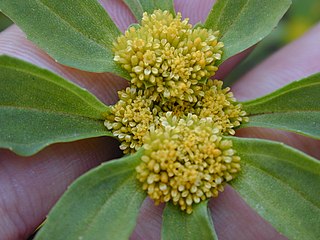
Flaveria trinervia is a species of flowering plant in the family Asteraceae known by the common names clustered yellowtops, speedyweed, and yellow twinstem. It is native to parts of the Americas, including the southeastern and southwestern United States, most of the Bahamas, Mexico, Belize, and parts of the Caribbean, especially Cuba, Cayman Islands, Jamaica, Hispaniola, Puerto Rico and Barbados. It is also known in many other places as an introduced species and often a noxious weed, such as in Hawaii.
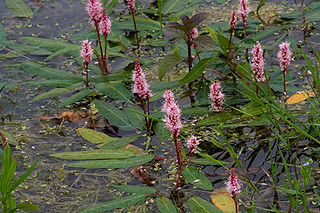
Persicaria amphibia is a species of flowering plant in the knotweed family known by several common names, including longroot smartweed, water knotweed, water smartweed, and amphibious bistort. It is native to much of North America, Asia, Europe, and parts of Africa, and it grows elsewhere as an introduced species and sometimes a noxious weed.
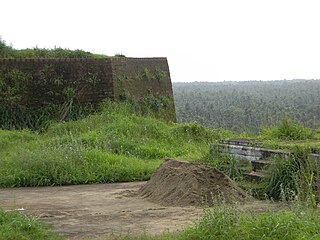
Madayipara is a flat-topped hillock located in the Madayi, of Kannur district of Kerala state in the Southern India. It overlooks the town of Payangadi on the northern bank of Kuppam River.

Nymphoides hydrophylla, commonly known as crested floating-heart, is an aquatic plant of the family Menyanthaceae native to tropical Asia. It has cordate floating leaves that support a lax inflorescence of dainty white flowers with fringed petal margins. Its slim stem (spear) is edible, and is used as vegetable in Taiwan, mostly produced at Meinong District, Kaohsiung.

Najas gracillima, the slender waternymph, is a submerged species of aquatic plant in the Hydrocharitaceae family. found in lakes and streams. It is native to China, Russian Far East, Japan, Korea, Taiwan, Iran, Alberta, Ontario, Newfoundland, Nova Scotia, New Brunswick, the eastern United States. It is also considered introduced and naturalized in France, Spain, Italy and California.

Hydrocleys nymphoides, the waterpoppy or water-poppy, is an aquatic plant species in the Alismataceae. It is widespread across South America, Central America, Puerto Rico, Trinidad and the Netherlands Antilles. It is cultivated in many places for used in decorative ponds and artificial aquatic habitats, and naturalized in Australia, New Zealand, South Africa, Fiji, New Caledonia, French Polynesia, Florida, Louisiana and Texas.
Nymphoides spinulosperma, commonly known as marbled marshwort, is an aquatic plant of the family Menyanthaceae native to eastern Australia. It was described in 1997.

Nymphoides crenata, commonly known as wavy marshwort, is an aquatic perennial herb of the family Menyanthaceae endemic to Australia, found in all mainland states and the Northern Territory
Nymphoides cordata, the little floatingheart, is a species of floating aquatic plant native to eastern North America.




















